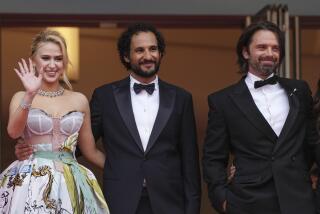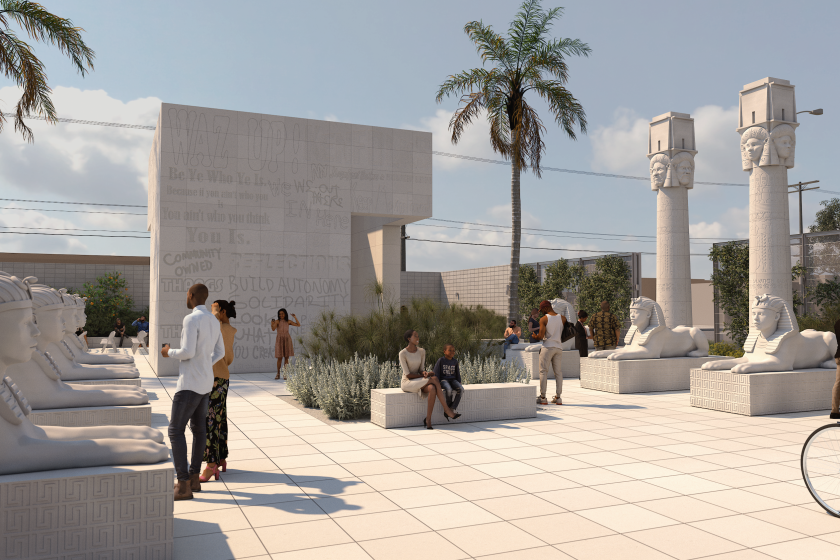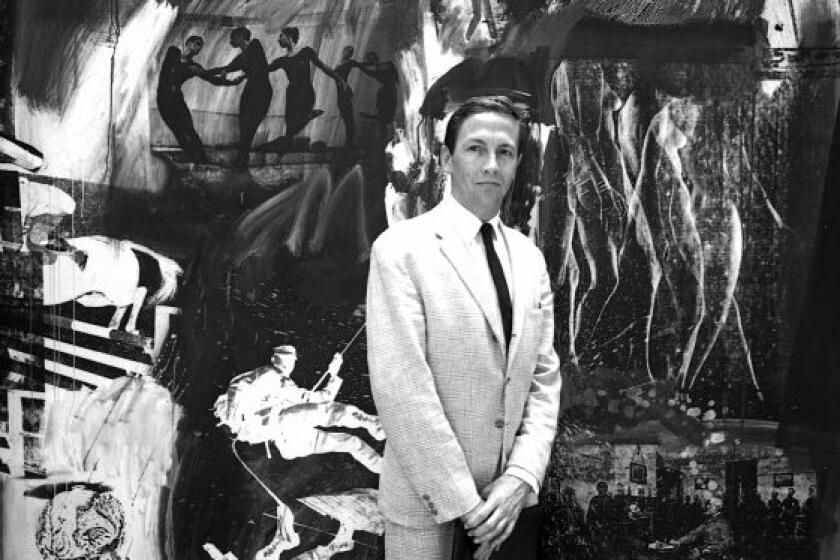Splendor on the Boulevard
All glamour fades. In Hollywood, there are few greater sins. But only those who accept the fact of decay are able to transform it.
In the design for the renovation of Sid Grauman’s once-fashionable Egyptian Theater, the L.A.-based architectural firm Hodgetts & Fung has avoided the false nostalgia that marks many restoration projects today. Nor did it erase the original vision by forcing the movie palace into the present. Instead, by inserting a new high-tech theater within the existing ruin, the $9.5-million project effectively locks past and future in a tight embrace.
Now an abandoned eyesore along Hollywood Boulevard, the Egyptian Theater will become home to American Cinematheque, a nonprofit independent film center that currently screens forgotten classics and the work of young and unknown talents. Groundbreaking on the project is scheduled for next week.
When it is completed sometime early next year, the project will not only recast one of the few remaining splendors of old Hollywood as a generous and complex public space, it will also stand as a thoughtful model of how to restore the tarnished image of Hollywood Boulevard.
Built in 1922, the Egyptian has gone through many incarnations. Grauman’s original vision was for a Moorish Spanish theater, but as Hollywood’s fickle tastes shifted, it was soon recast in an Egyptian motif. When it opened, thick plaster columns and pharaohs’ heads guarded the entry. Above, a would-be actor clad in mock Egyptian garb paced back and forth across the rooftop.
As a theater, the Egyptian left much to be desired. Some seats were scattered off in the wings, with impossible views; others were lodged uncomfortably under a low balcony. The screen itself was dwarfed by an enormous Egyptian-style proscenium arch. The layout was so strange that, in order to reach the projection booth, the projectionist had to walk across the roof.
Still, what the Egyptian lacked in screening amenities, it made up for in star quality. Much of the site was taken up by the glitzy courtyard entrance, and it was the courtyard that mattered most, since it was there that the real Hollywood drama was played out. Ablaze in Klieg lights, rows of gawkers would cram together along its edges, while silver screen luminaries glided along to their films’ premieres. Photographers squatted along a nearby rooftop, bulbs flashing.
That kind of glamour is long gone. During the ‘50s, former Elizabeth Taylor consort Mike Todd bought the theater and removed the enormous proscenium arch to create a nondescript wide-screen theater. The exterior columns were torn out and replaced with a dim glass-and-steel facade. By 1993, when the Community Redevelopment Agency took it over, the theater had been closed. The final indignity came with the Northridge earthquake in 1994, when walls crumbled, and many of the clay tiles--embossed with fake hieroglyphics--were bashed out.
Meanwhile, American Cinematheque had long been homeless: Nearly a decade ago, plans were made to house the nonprofit group in Beverly-Fairfax’s Pan-Pacific Auditorium, but the auditorium--one of the city’s true architectural landmarks--burned down in 1989. Later, the group was part of a plan to create a film and museum complex at the corner of Hollywood and Highland, but that project collapsed in the face of scathing community opposition. Last year, the CRA sold the Egyptian to Cinematheque for one dollar.
Faced with a crumbling theater and a puny budget, the architects chose to treat the old theater as an empty shell and insert new high-tech spaces inside. Old and new would share the same space, but never meld. The past--in a blunt nod to Egyptian archeology--becomes a broken fragment that is recycled.
Inside, the theater’s curved, 50-foot-high walls will be cleaned and restored. Visitors will move down long ramps along those faux stone walls to their seats. But once the room darkens, overlapping plywood-clad panels--punctured with a grid of holes to heighten the acoustics--will slide back along both sides of the audience, enclosing them in a more intimate, futuristic space, focusing their attention on the screen.
It is a dramatic gesture. This theater within the theater will become an elaborate technological cage--with refitted original projector units, satellite feeds and a THX sound system with about 80 speakers. There is no heavy curtain here. The screen is bare; it is the audience that is now enclosed.
That strategy of insertion extends into the rest of the theater as well. The back rows--those that were once lodged awkwardly under the balconies--have been torn out to make room for a secondary 74-seat screening room and an extended lobby. The screening room, again, is designed as a free-standing structure, its low-vaulted roof curving down to expose the original patterned ceiling above.
The architects were as eager to preserve the building’s scars as they were its idiosyncrasies. In the lobby, a large stain--where the room suffered extensive water damage--cuts across the Egyptianoid ochre, gold and cobalt blue stenciled walls. It will stay, to preserve the layers of change.
No radical additions were necessary in the courtyard, which will basically serve the same function it did 75 years ago. The ‘50s-era glass-encased lobby will again become an open-air portico, framed by four 34-foot columns. Nearby, the two giant pharaoh heads will rest on their own thick pillars. The only addition will be twin rows of palm trees that will shade the open court, and a small newsstand stocked with trade journals. The effect will be to create a more layered public space--a series of thresholds that lead from the street into the theater.
“It may be that only ruins express a fact completely,” wrote Italian architectural theorist Aldo Rossi. “ . . . Photographs of cities during war, sections of apartments, broken toys. Delphi and Olympia.”
That is the hopeful intent of the new old Egyptian. Today, our cities seem dumbly content to succumb to the clumsy, over-scaled developments that are meant to transform their blighted neighborhood relics into overnight tourist attractions. Coming soon a few blocks away from the Cinematheque project is a proposed 12-screen cinema plus mall megadevelopment. It is a now-too-familiar event: homogeneity, estrangement, profit, all veiled under the soothing glow of bright colored lights.
Projects like the Egyptian Theater renovation imply a richer and more complex understanding of the city and its history--recycling the past without the pretense of re-creating it. They manage to preserve the quirky, the eccentric, as well as the glamorous. Think hard, and remember what we’ve lost.
More to Read
The biggest entertainment stories
Get our big stories about Hollywood, film, television, music, arts, culture and more right in your inbox as soon as they publish.
You may occasionally receive promotional content from the Los Angeles Times.






